Flight to Mars: non-Gomanovsky trajectory, air braking and landing difficulties in a rarefied atmosphere
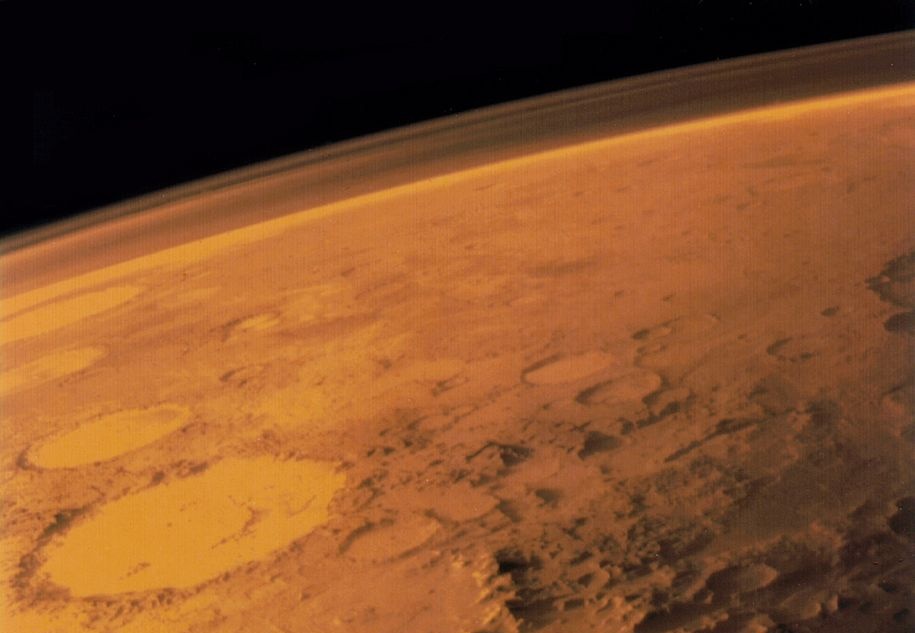
Autumn, sadness, nostalgia. It's time to unwind, arrange an educational quest for yourself, flying to Mars. Virtually, of course, in Orbiter. And to make it more interesting, we will not slow down Mars by engines, but by friction against the atmosphere.
Flight plan
For the most understandability and convenience, our flight will be divided into simple stages:
- Start from Earth.
- Combining the planes of the orbits.
- Acceleration to Mars.
- Trajectory corrections on the way to Mars.
- Entrance corridor.
- Braking in the atmosphere.
- Preparing for landing.
- Atmospheric flight and landing
Flight preparation
In addition to Orbiter itself, we only need AerobrakeMFD (the archive can simply be unpacked into the folder of the installed simulator).
Definitions Used
If you have not read the previous publications of the series, it is worth expanding.
Apocenter is the highest point of the orbit. For the orbit around the Earth, the name "apogee" is also used.
The pericenter is the lowest point of the orbit. For the orbit around the Earth, the name "perigee" is also used.
Orbital inclination - the angle between the orbital plane and another plane (the plane passing through the Earth's equator or the orbital plane of another body) An
ascending node is the point at which the orbit intersects the Earth’s equator plane or the orbit plane of another body, appearing “above” it. “Above” and “below” are defined by the conditional north and south poles.
Descending node- the point at which the orbit crosses the plane of the equator of the Earth or the plane of the orbit of another body, being "below" it. “Above” and “below” are defined by the conditional north and south poles.
For example, if we are talking about the orbit of the moon around the earth, the picture will be as follows:

The pericenter is the lowest point of the orbit. For the orbit around the Earth, the name "perigee" is also used.
Orbital inclination - the angle between the orbital plane and another plane (the plane passing through the Earth's equator or the orbital plane of another body) An
ascending node is the point at which the orbit intersects the Earth’s equator plane or the orbit plane of another body, appearing “above” it. “Above” and “below” are defined by the conditional north and south poles.
Descending node- the point at which the orbit crosses the plane of the equator of the Earth or the plane of the orbit of another body, being "below" it. “Above” and “below” are defined by the conditional north and south poles.
For example, if we are talking about the orbit of the moon around the earth, the picture will be as follows:

Stage 1. Start from the Earth
First of all, you need to enable the “endless fuel” mode in the “Parameters” section by unchecking: The
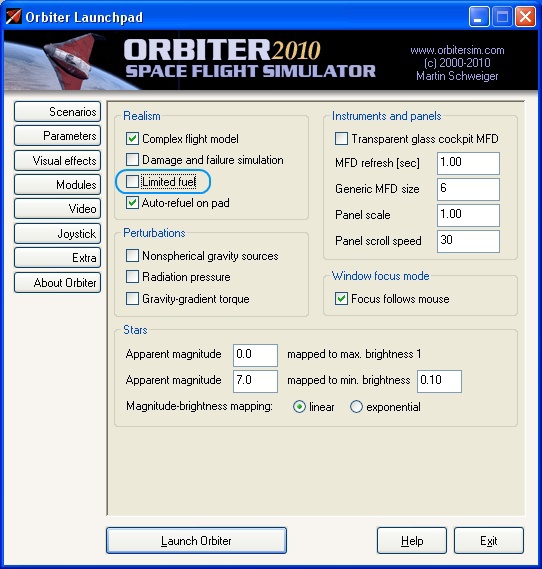
script we need is “DG-S ready for takeoff” in the Delta-glider folder. In it, our ship is already standing on the runway at Cape Canaveral, ready for takeoff.

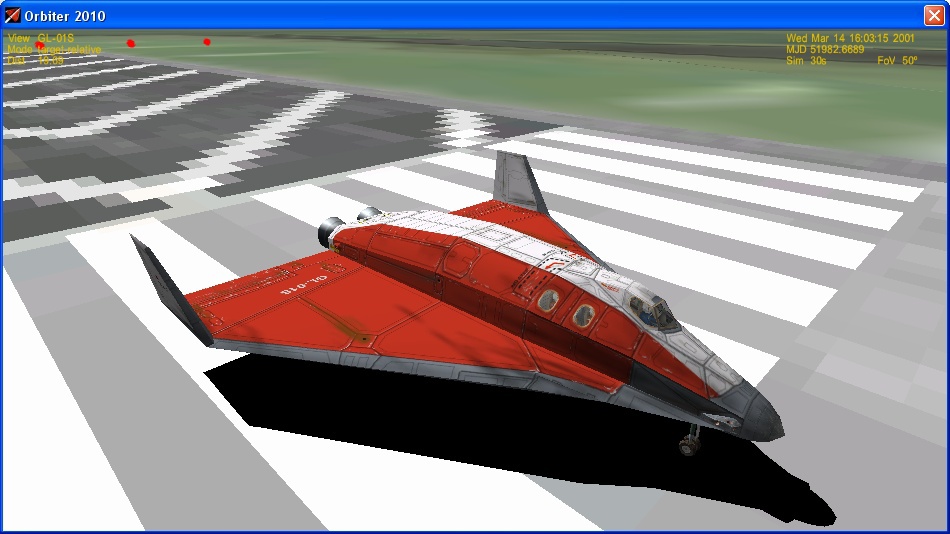
Delta glider - Orbiter's workhorse
Pressing F1 we will switch to the “view from the cockpit” mode. By pressing F8 we switch the view to the “glass cockpit” mode.
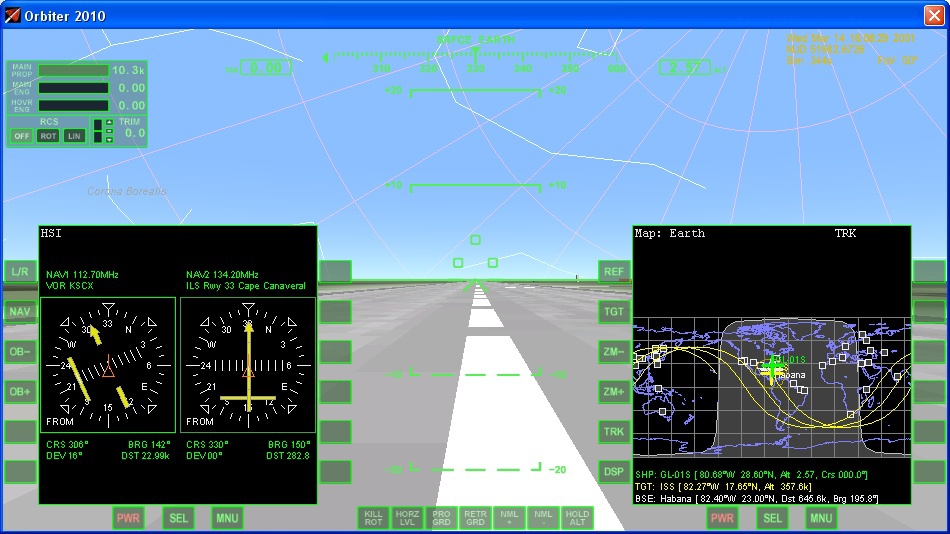
On the left and right are multifunction displays (MFD, MFD). We will display various devices that we will need in flight on these displays. MFD hotkeys are used with pre-pressed left and right Shiftfor left and right MFD, respectively. The MFD selection menu is called up by pressing Shift-F1 or by clicking on the MNU button under the MFD. The cockpit is interactive, if you are too lazy to remember hot keys, you can click the buttons with mouse clicks. Switch left MFD mode "Surface" by pressing Shift - F1 , Shift - S , and the right mode "Orbit" pressing Shift - O . For convenience of displaying, we will change the projection mode on the right MFD from ecliptic to ship by pressing Shift - P (MFD will replace ECL with SHP in its upper right part) and change the mode of measuring the height from the center of the celestial body to the height from the surface with the Shift - D combination(MFD will replace the distance of the pericenter and apocenter PeR and ApR to the heights of the pericenter and apocenter PeA and ApA).
I recommend to remember one key combination - the Ctrl - P . On it you can always pause the simulator.
The second very useful set of hot keys controls time - R - slows down time by 10 times, T - speeds up by 10 times.
Before takeoff, you must still turn on the orientation system engines ( Ctrl - / on the numeric keypad) and set the trimmer all the way up, holding the Delete button above the block of cursor keys.
Turn on and fix the marching engines (press Num + , then Ctrl, release Num + , release Ctrl ). We start the run. If the trimmer is correctly installed, the ship will begin to tear itself away from the strip on its own:
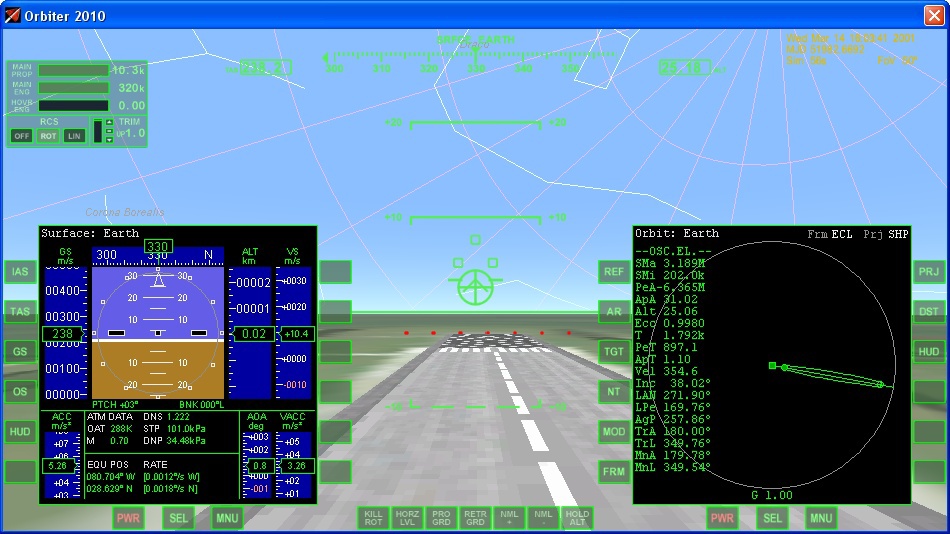
remove the chassis (button G ) and, controlling from the numeric keypad, turn the ship around 90 °. By controlling the trimmer ( Insert down, Delete up) and the KillRot rotation stop mode ( Num 5 ), we start acceleration, maintaining a pitch angle of 20-30 °.
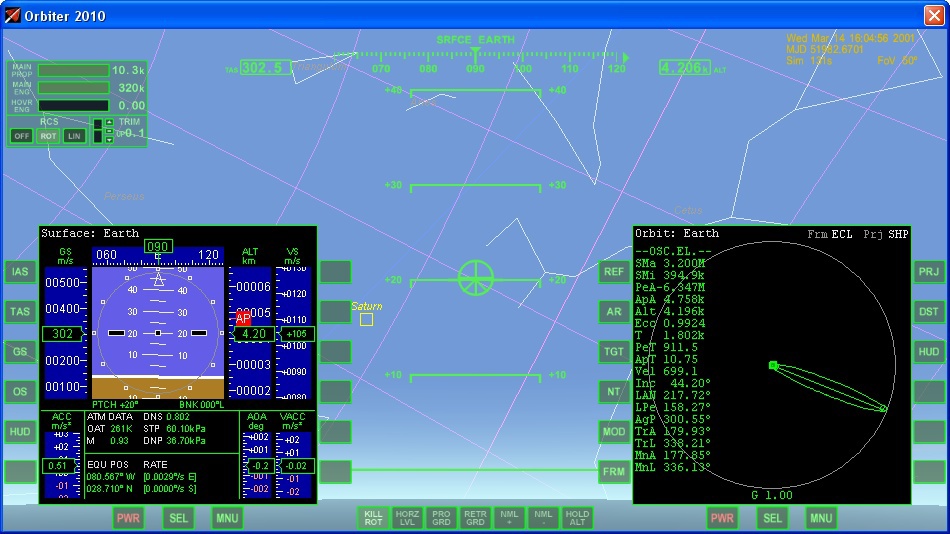
Starting at a height of ~ 30 km, trimmers and KillRot mode will no longer cope. You can not interfere with the control (in this case there will be sections of a slight decrease), you can switch to 2D cockpit mode (by pressing F8 ) andto change the thrust vector of marching engines , it will not hurt to enter orbit. We accelerate until the apocenter of the orbit reaches 200 km.
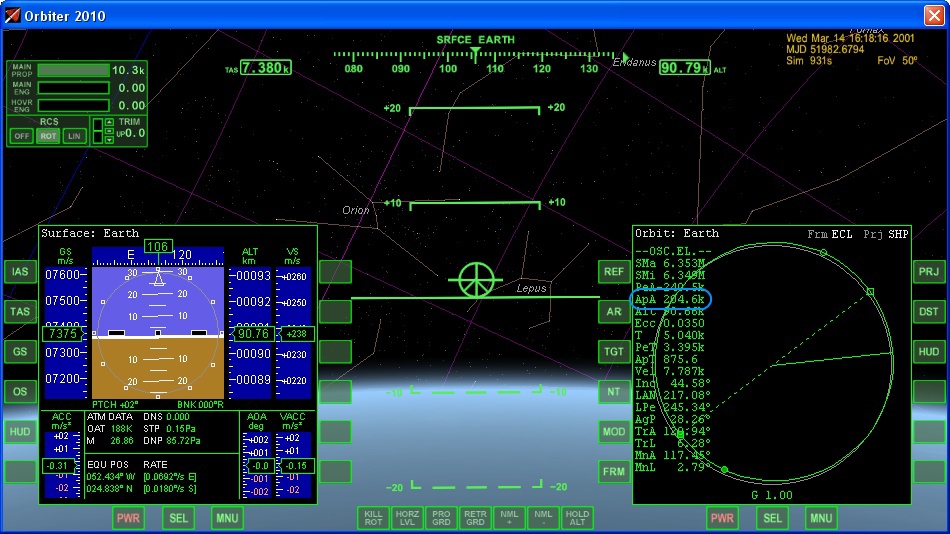
Turn off the main engine with the Num * button . We occupy a position along the orbital velocity vector (PROGRD mode [ ) and wait for the apocenter. In the apocenter area, turn on the main engine again and raise the pericenter to ~ 200 km.

So, we are in a circular support orbit ~ 200 km. For the convenience of the further flight, we will open the brake engine flaps ( Ctrl - Space , Retro Doors - Open). We translate the indicator on the windshield (ILS) into orbital mode by pressing the H button .
Stage 1 completed successfully. Save by pressing Ctlr-S . The saved game will lie in the Quicksave folder and it can be downloaded in exactly the same way as the script at the beginning:
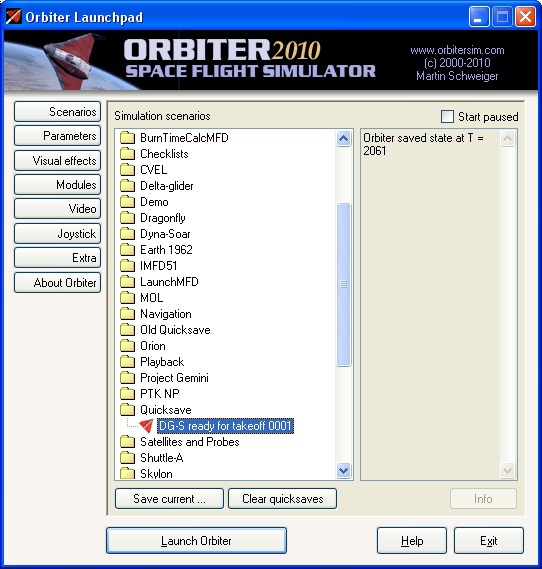
I don’t know about you, but it seems to me that the psi ambient is perfect for such flights:
Stage 2. Alignment of the planes of the orbits
In order for us to accelerate normally to Mars, it is necessary to combine the plane of our orbit with the plane of the orbit of Mars. To do this, we need the MFD “Alignment of the orbit planes” ( Shift - A ). Let's choose Mars ( Shift - T , select Celestial Bodies - Mars from the menu):
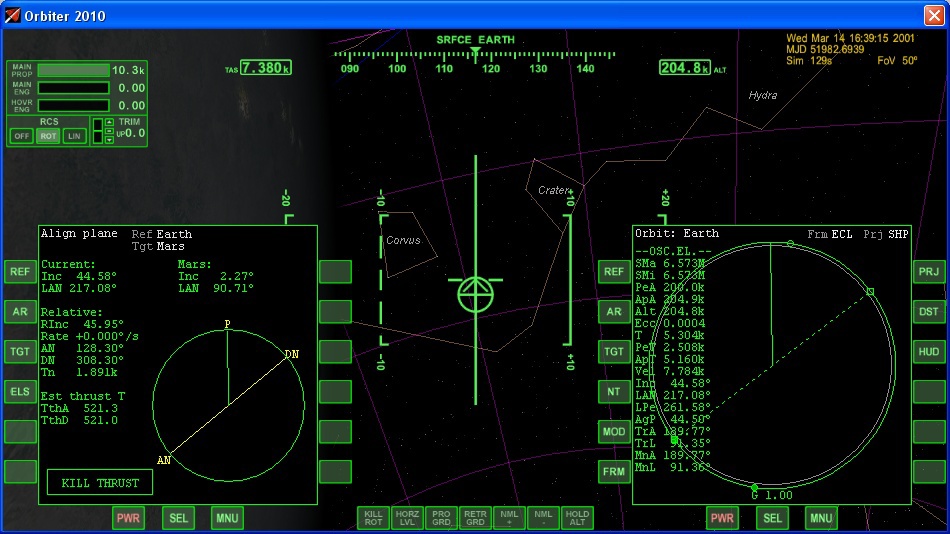
The next node is ascending (Ascend Node, AN), so you need to take a “down” position from the orbit plane. There is NML- mode for this (button ' or click on the NML- button at the bottom of the screen). Let's wait for the point at which the time to the node (Tn on the MFD) will be approximately half the maneuver time in the node (Est Thrust T), and turn on the main engine in it:

Why half the time to the node? The fact is that during the maneuver the line of nodes is shifted, so if you start correcting the orbit in a time equal to the time of maneuver in the node, the node “leaves”. The same offset line nodes is a criterion for stopping the engine. When the line of nodes is almost perpendicular to the green line, further correction does not make sense.
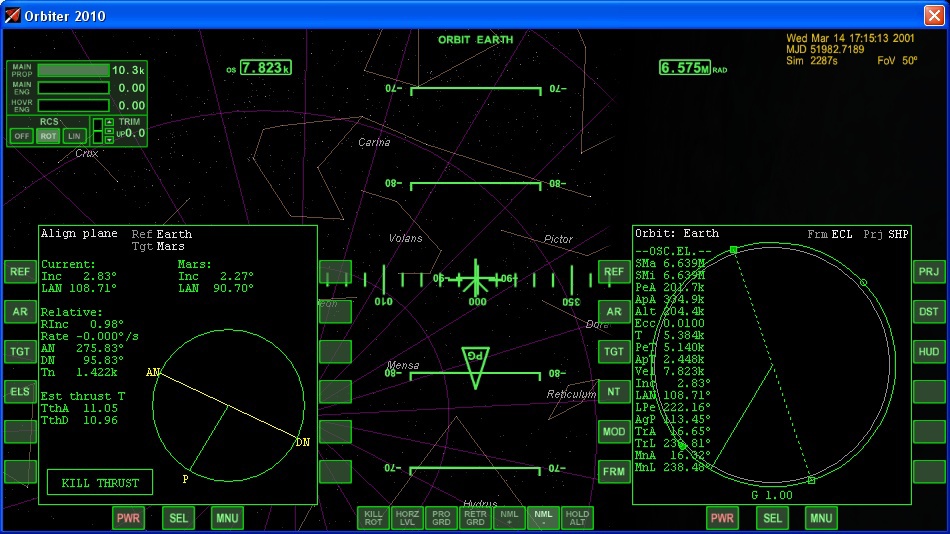
Thanks to this simple formula, we practically combined the planes of the orbits from one maneuver. But it is worth repeating the maneuver for maximum alignment of the planes:
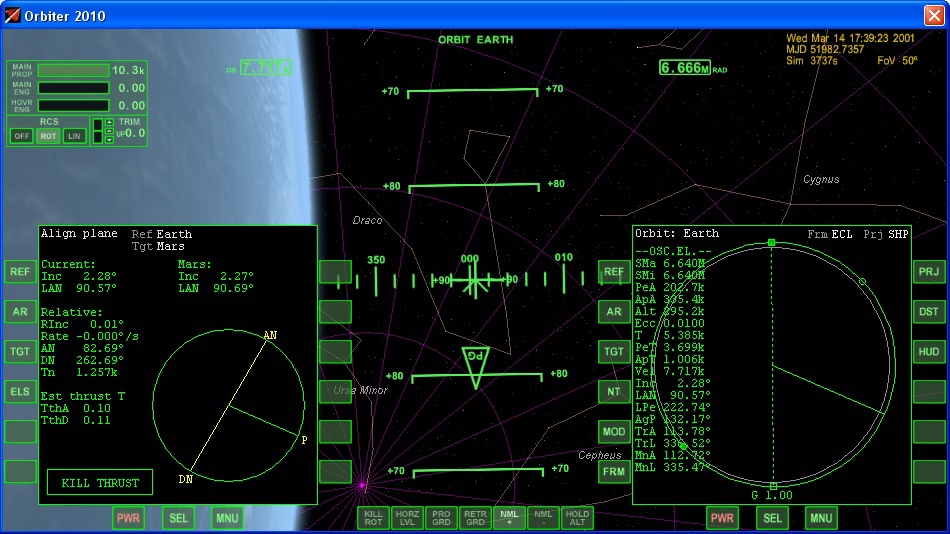
We have completed the second stage. Do not forget to save.
Stage 3. Acceleration to Mars
To prepare the maneuver, turn on the MFD Transition ( Shift - X ). Our goal is Mars, which revolves around the Sun, therefore we will indicate the Sun as the central body ( Shift - R , select Sun in the menu). We revolve around the Earth, therefore, we will indicate the Earth as the initial body ( Shift - S , select Earth in the menu). Choose Mars target ( Shift - T , select Mars in the menu). MFD will look like this (clarifications added for clarity):
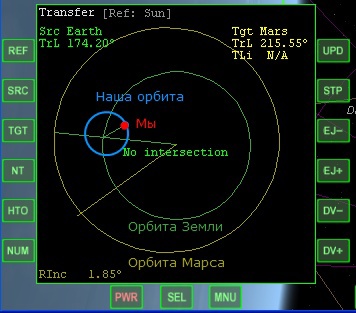
We turn on the maneuver planning mode ( HTO button on the MFD). The dotted radius of the start point of the maneuver appears. It can be moved by pressing Shift - < and > . The planned pulse is controlled by the Shift - - and + buttons . Aim on Mars:
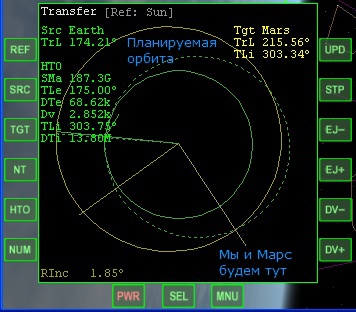
Note that the Mars intercept point is not on the opposite side of the orbit. This means that our trajectory will not be Gomanovskaya , we will spend more fuel, but then fly faster.
MFD writes that we need to accelerate to 2.8 km / s. Our current orbital speed is 7.6 km / s. Everything seems to be simple: 7.6 + 2.8 = 10.4 km / s. But this is not true! Our ship is in Earth orbit. And the Earth, in turn, revolves around the Sun. It turns out such an interesting picture: the

2.8 km / s that the MFD offers us must be added to the orbital velocity of the Earth, and not us. The situation is further complicated by the following factors:
- In order to leave the Earth’s orbit, it is necessary to accelerate to a second cosmic velocity (11.2 km / s).
- Orbital velocity non-linearly depends on the height of the orbit .
- When moving away from the Earth, our speed will fall due to the transfer of kinetic energy to potential.
- Acceleration is not instantaneous; during acceleration, part of the speed will already be lost in the transition to potential energy.
In principle, there are special MFDs for calculating the desired speed, but they have a fairly high entry threshold. Therefore, we will cut this Gordian knot very simply: we’ll accelerate to the second cosmic velocity, adding 500-1000 m / s to it “by eye”, and, having already moved away from the Earth, we will correct the trajectory. We start acceleration on the night side of the orbit so that our orbital velocity is added to the orbital velocity of the Earth:
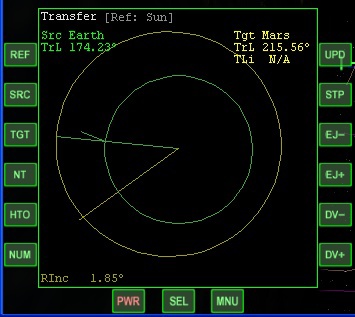
We track the parameters of the orbit on the right MFD "Orbit":
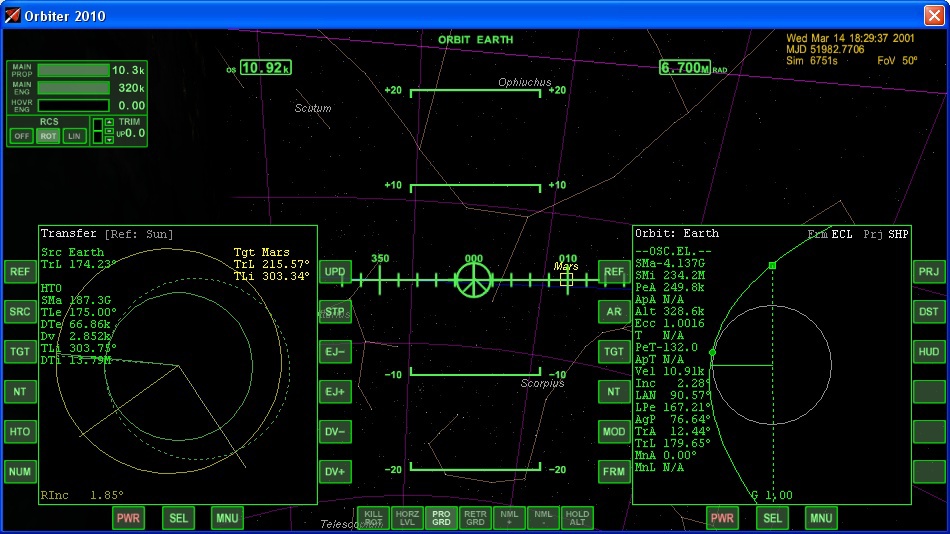
There is a second space! Please note that the speed is not 11.2 km / s. Stop acceleration at speeds around 11.5 km / s, so as not to accelerate too much.
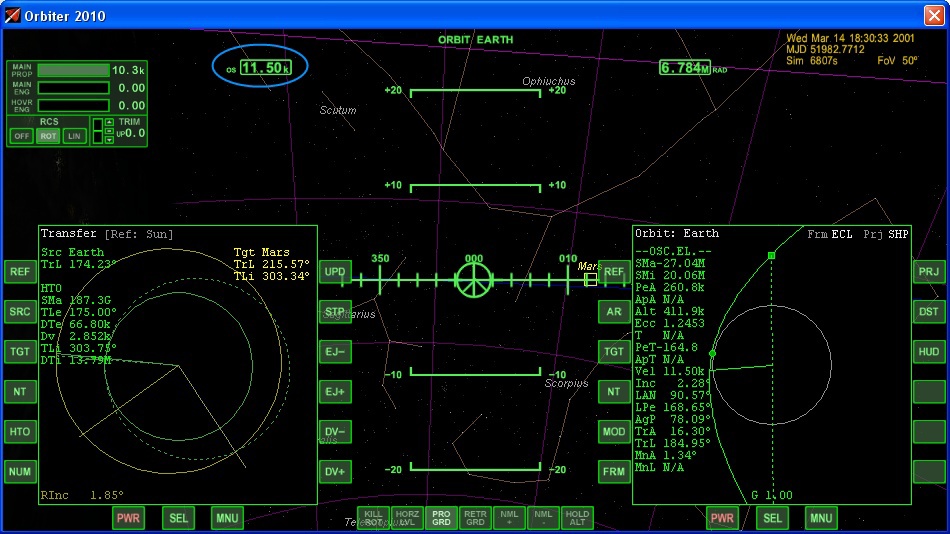
We stabilize the ship in space by turning on the KillRot mode. Speeding up the time, we roll it up to the moment when the gravitational impact of the Earth will practically come to naught. We choose ourselves as the initial body ( Shift - S , type in the text box our name GL-01S ). Accelerated
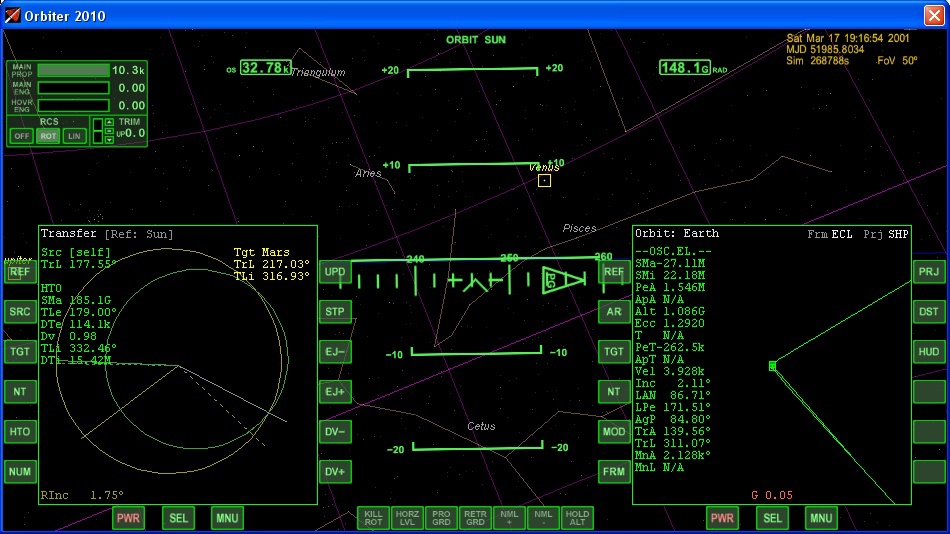
quite well: Now our task is to correct the orbit so that we aim approximately at the point of meeting with Mars. Visually, this can be represented as follows:
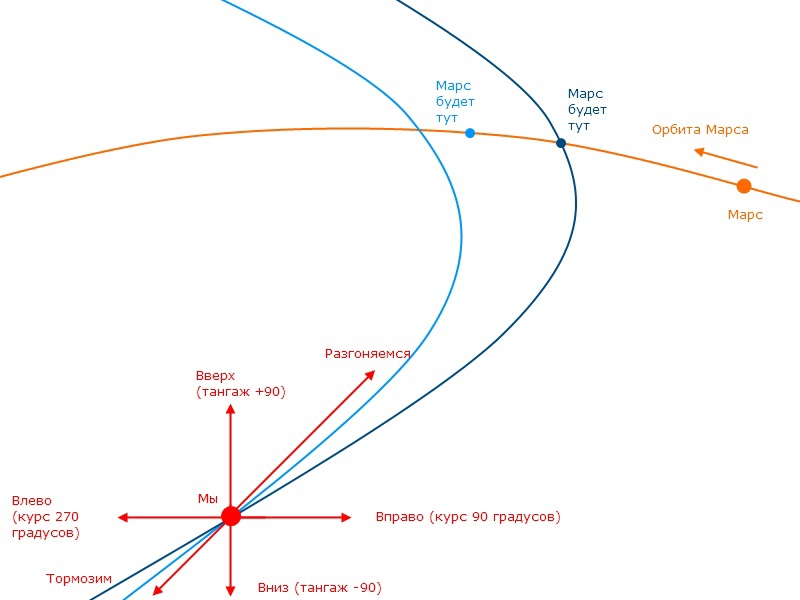
MFD orbit synchronization will help us in accurate aiming ( Shift - Y, select Mars as the target by Shift - T ). Our task is to decrease the value of the DTmin parameter by pulses to the right, left, up, down, forward, backward:

Common sense tells us that when correcting, it is worth giving pulses to the right. We occupy a position of 90 ° to the right and, holding it manually (there is no automatic mode), turn on the main engine. A noticeable decrease in DTmin:
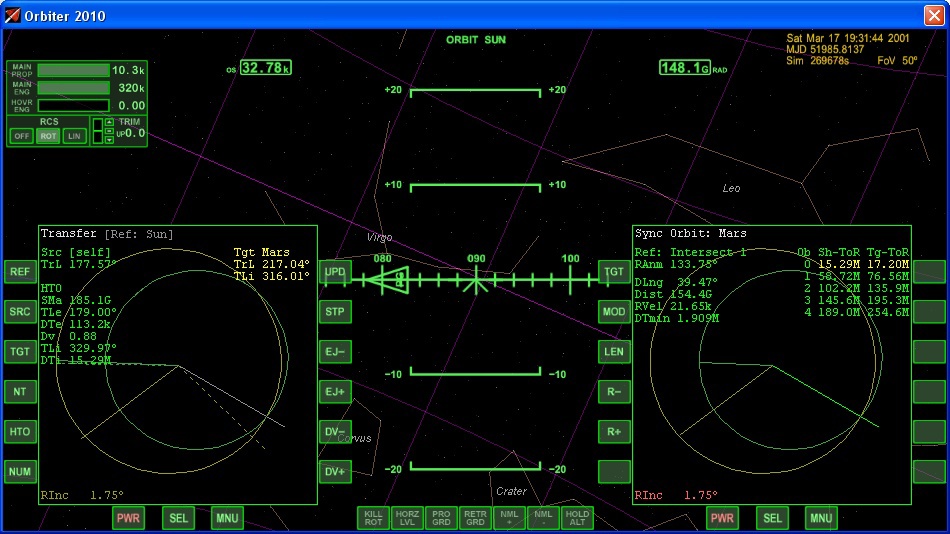
The algorithm for further actions is simple. When DTmin stops decreasing before reaching a near-zero value, we change the axis - we check whether it will decrease its shift up / down or forward / backward. If we combined the orbits well in stage 2, this will most likely not happen. Result of correct actions:
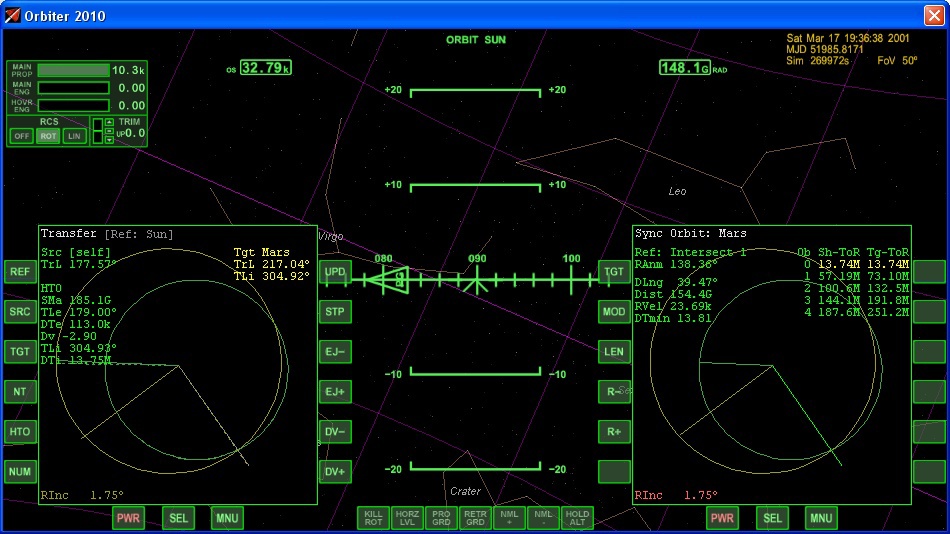
Stage 3 is completed. Do not forget to save.
Stage 4. Trajectory corrections on the way to Mars
Mars is a relatively light planet. This is not Jupiter, which did not require intermediate corrections during the flight. Therefore, we will adjust our trajectory several times so as not to fly past. The first step will be a complete alignment of the orbit planes and the first path correction. If you look at the MFD of the orbit synchronization, it shows the angle of the orbital planes at almost two degrees. It must be fixed, because the MFD cannot work normally in such conditions. Therefore, we switch the left MFD to the mode of combining orbital planes. He “remembers” the previous body of revolution - the Earth, so you need to switch it to the Sun ( Shift - R, select Sun from the menu). The next node is ascending, almost five megoseconds before it (involuntarily I recall Vindzh's “Depth in the Sky”, where time was measured with such units): We

combine the planes of the orbits:

Then we decrease the DTmin. I recommend changing it while accelerating / braking, and in no case move up / down - we have already combined the orbit planes. When DTmin is close to zero, small shifts are best done not by marching, but by shunting engines:
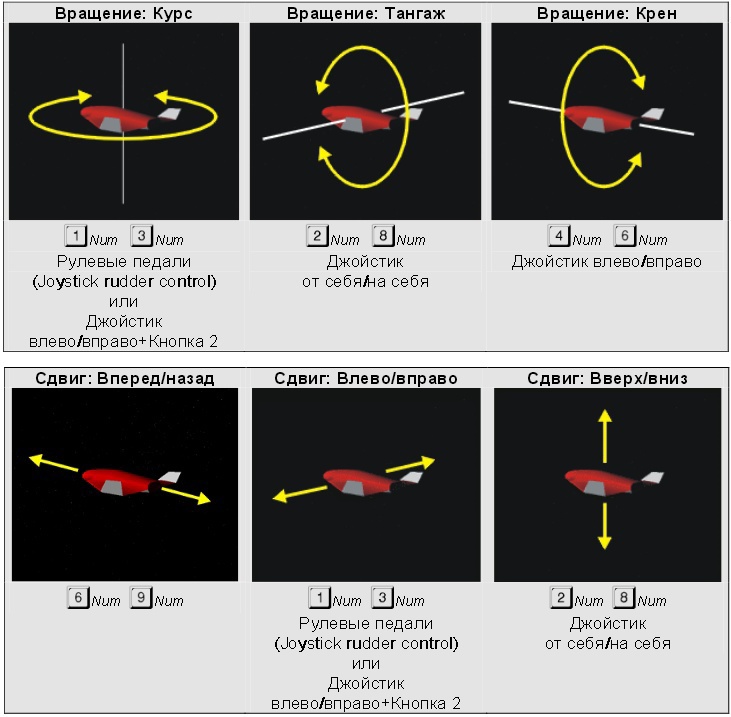
After accurate aiming, DTmin will be almost zero:
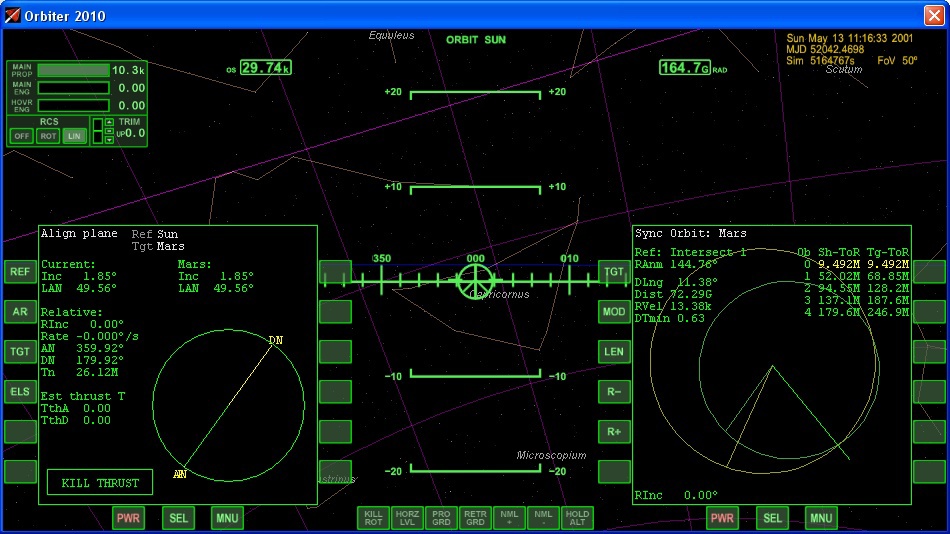
To the meeting point, 9.5 megoseconds. I propose to make corrections using the dichotomy method - for five, two and a half and one megasecond.
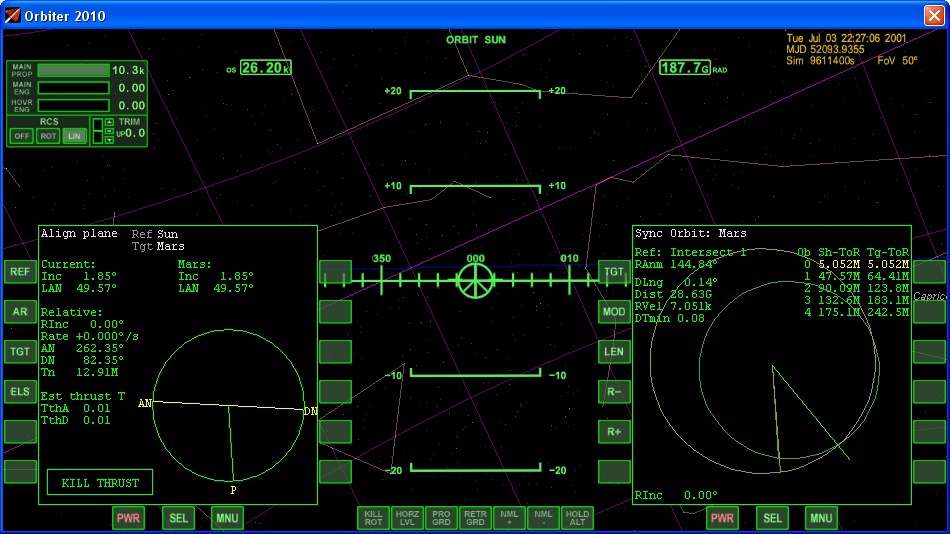
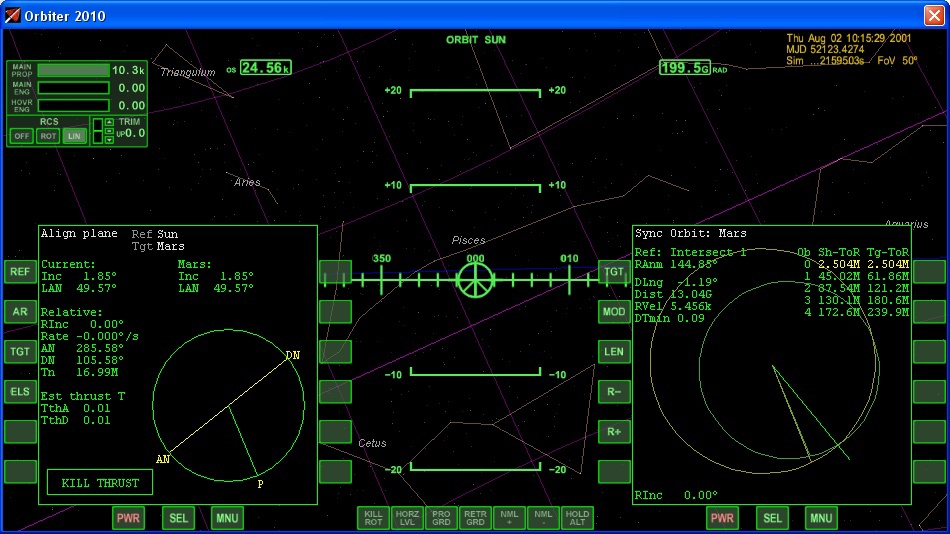

Stage 4 is considered to have ended 1 megosecond from the meeting point. Do not forget to save.
Step 5. Entrance corridor.
What is an entry corridor? We need to approach Mars so that, on the one hand, it does not crash into it, and on the other hand it does not fly by. Our goal is the pericenter of 20 km, so that we reliably enter the atmosphere and can slow down. Switch the left MFD to the “Orbit” mode ( Shift - O ) and select Mars as the body of revolution ( Shift - T , select Mars in the menu). We skip time until the gravity of Mars begins to be felt (20-30 kiloseconds to the meeting point):

Apocenter is negative, we will have to crash into Mars. It is necessary to raise the apocenter to 20 km. To do this, turn your nose to the planet, increase Mars (the Z button decreases the field of view, the X button increases it).

I choose braking on the day side. At night, in conditions of time pressure, you can lose orientation in space, which is potentially dangerous.
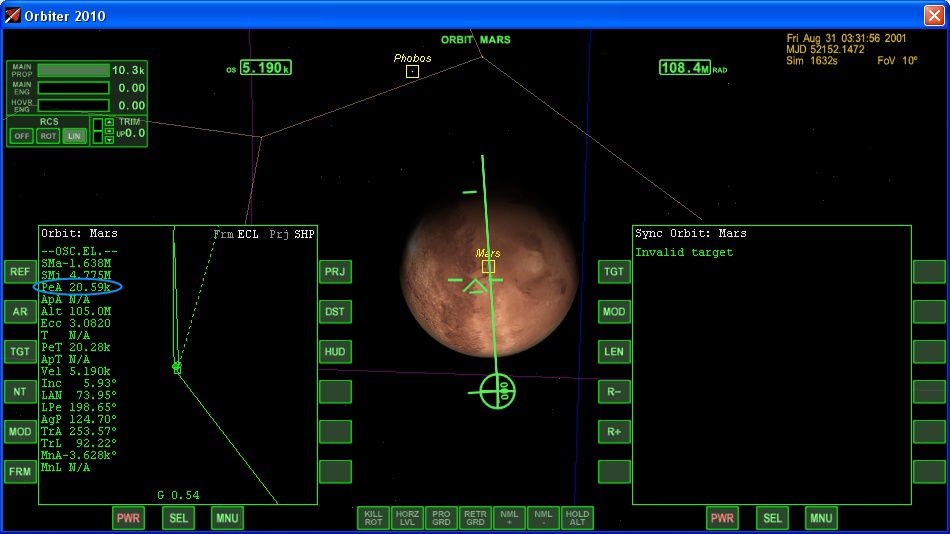
Pericenter 20 km. Stage 5 is complete. Be sure to save!
Stage 6. Braking in the atmosphere
We will set the “Surface” mode on the right MFD, return the normal field of view, turn the ship in the direction of travel, and morally prepare for the difficult stage.

Our main controls will be the trimmer, which we already used on take-off from the Earth, and aerodynamic brakes (released and cleared by pressing Ctrl - B ). Set the trimmer all the way up and release the brakes. We switch the HUD to the “surface” mode by pressing H and take a position with a roll of 90 °:
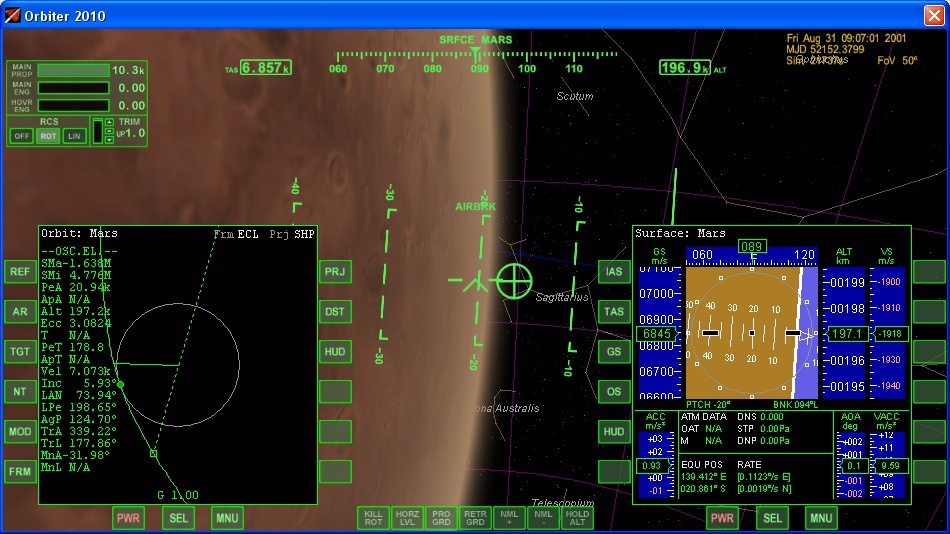
Having reached the pericenter, we control the roll so as to maintain near zero vertical speed and continue braking:

When the apocenter height is below 1000 km, we remove the air brakes and begin to get out of the atmosphere:

Upon reaching Apocenter we raise the pericenter above 100 km:
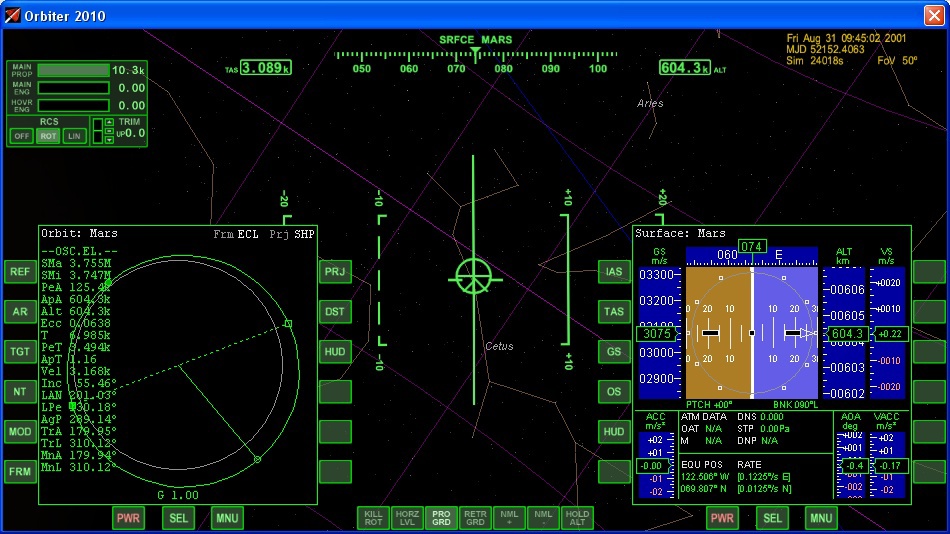
Everything, we are in a stable orbit around Mars. Be sure to save.
In theory, you can build an approach so as to approach the landing immediately from this stage. But this, firstly, is difficult, and secondly, it requires very fast work with several MFDs in parallel with piloting the ship, which increases the chances of an error. I preferred to go a longer, but simpler and safer way.
Historically, air braking was used by Martian devices. For example, an aerodynamic braking MRO saved about half the fuel that would be required for normal braking. Of course, the apparatus did not slow down as hussars as we did. MRO reduced the height of the apocenter gradually, repeatedly braking in the upper atmosphere.
Stage 7. Preparing for landing
Our goal is the Olympus base, which, as the name implies, is located near Olympus, the highest mountain on Mars and the second highest in the solar system:
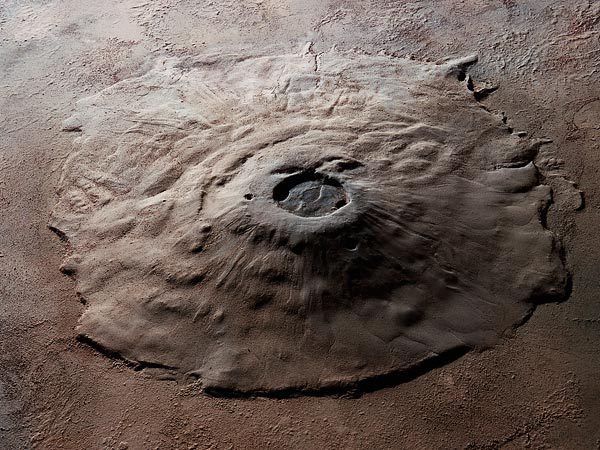
This stage consists of several parts.
Preparation of MFD cards. Let's open the MFD cards ( Shift - M ) and choose the Martian Olympus base as our target ( Shift - T , choose Spaceports - Olympus).
Preparation of MFD Aerobrake. Open the MFD ( Shift - E ), set the Olympus base as the target ( Shift - T , enter Olympus from the keyboard), switch the MFD to map mode by pressing the PG and PRJ buttons.

Preparation of MFD communications. Open the MFD ( Shift - C ). Let's open the menu with the data of radio beacons ( Ctlr - I) The Olympus base has three landing sites (alas, no runways), the first of which has a beacon operating at a frequency of 129.70 MHz. Set this frequency in the MFD by pressing the MFD <, <<,>, >> buttons.

Then you need to plan a landing. Our non-zero inclination of the orbit means that our trajectory will move along the surface. Also now the base "Olympus" is on the night side. Therefore, while in orbit, we are waiting for the coincidence of two factors - the base is on the day side and our trajectory passes near it. If necessary, you can slightly change the inclination of the orbit. In my case, I did not have to wait long, ten turns:

When 4-5 thousand kilometers remain to the base, we perform a braking maneuver so that a thousand or two kilometers of shortage remain to the base and we orient the ship nose forward:
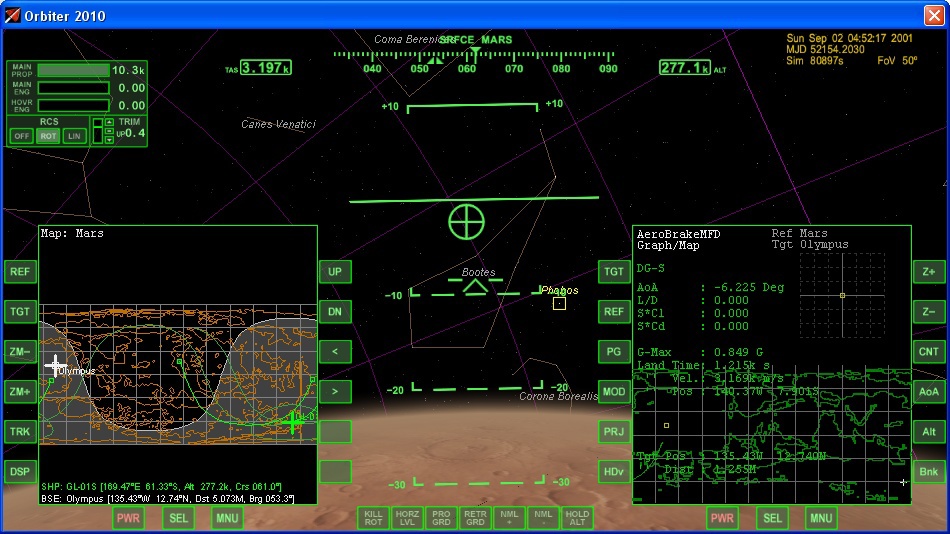
The stage is completed, be sure to save!
Stage 7. Atmospheric flight and landing
MFD cards can be put into centering mode on the ship ( TRK button on MFD). Our main controls will again be the trimmer and aerodynamic brakes. By managing them we maintain a trajectory to the base area on the Aerobrake MFD.
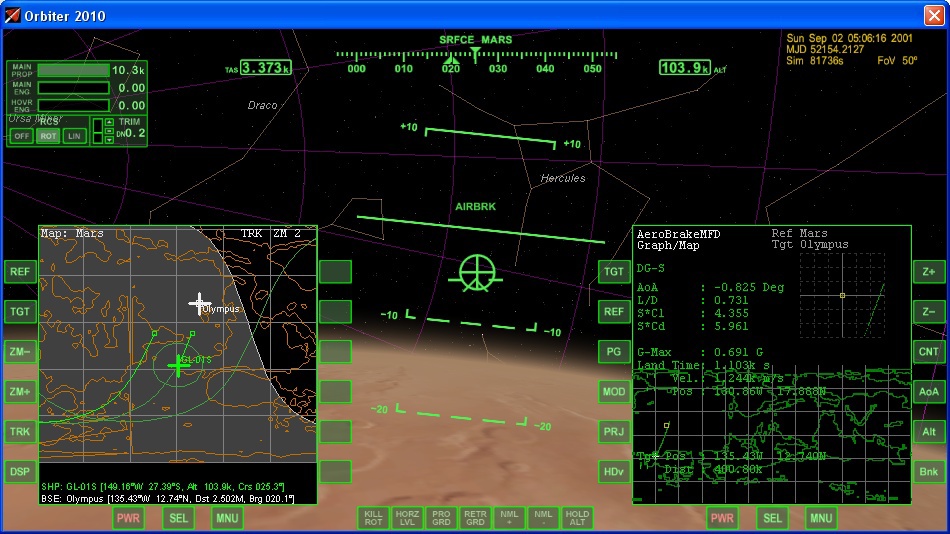
We continue active management.
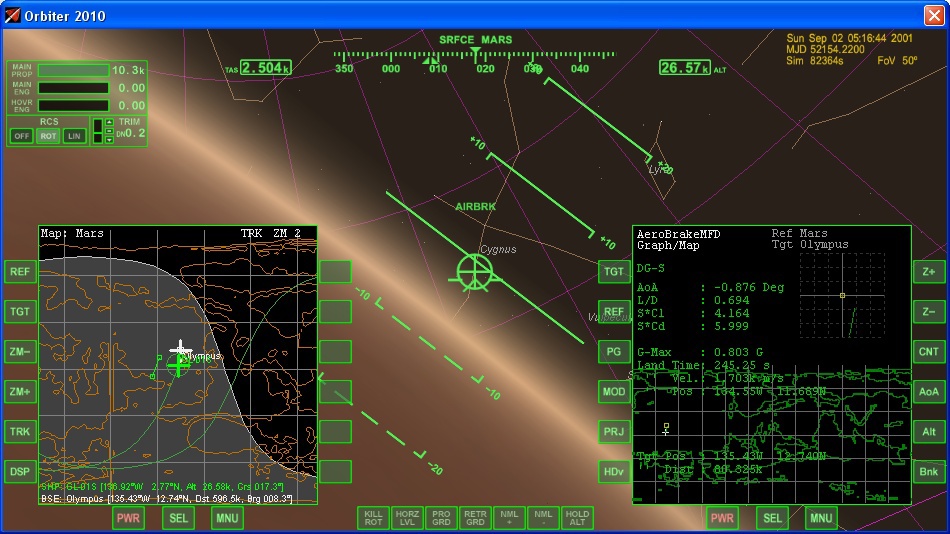
The problem with the Martian atmosphere is that it is too weak. She is not able to quickly and efficiently slow us down. Therefore, you will surely fly over the base:
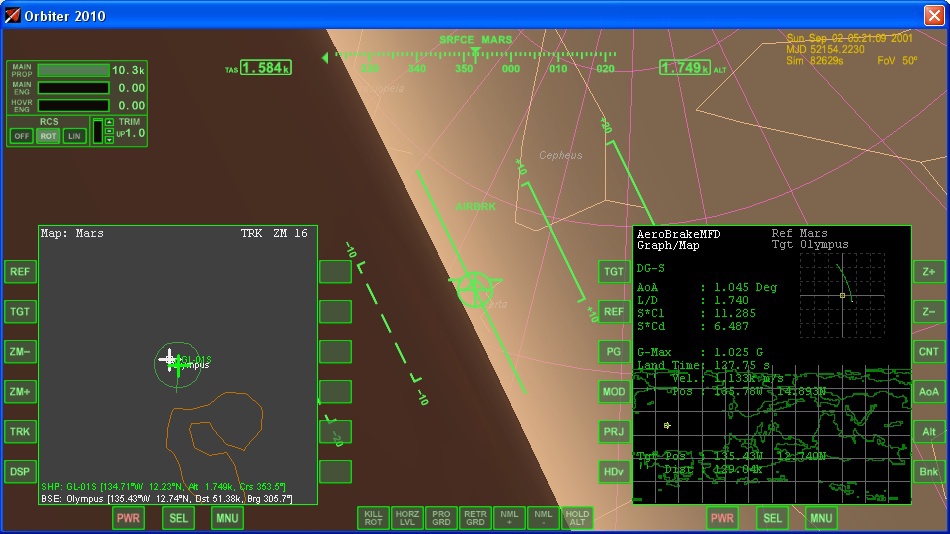
There is nothing to worry about. Because of the atmosphere, we, in any case, will not be able to turn around and slow down with marching engines, as on the Moon , so the rest of the speed will have to be reset in a U-turn. Watch for altitude - do not hit the Mars. In a U-turn, you can help yourself with lifting motors ( Num 0increase traction, num. - decrease): We turn

in the direction of the base, it is still ~ 50 km. While supporting the ship in the air with lifting motors, we continue the approach.

We turn on the automatic mode of maintaining horizontal orientation ( L ). Switch to the MFD landing ( Shift - L ). It is good in that it shows the direction and distance accurately enough.
The brake motors are very weak. Try to adhere to the rule: the horizontal speed in hundreds of meters per second should not be higher than the distance in tens of kilometers. Otherwise, there is a risk of flying over the base a second time:
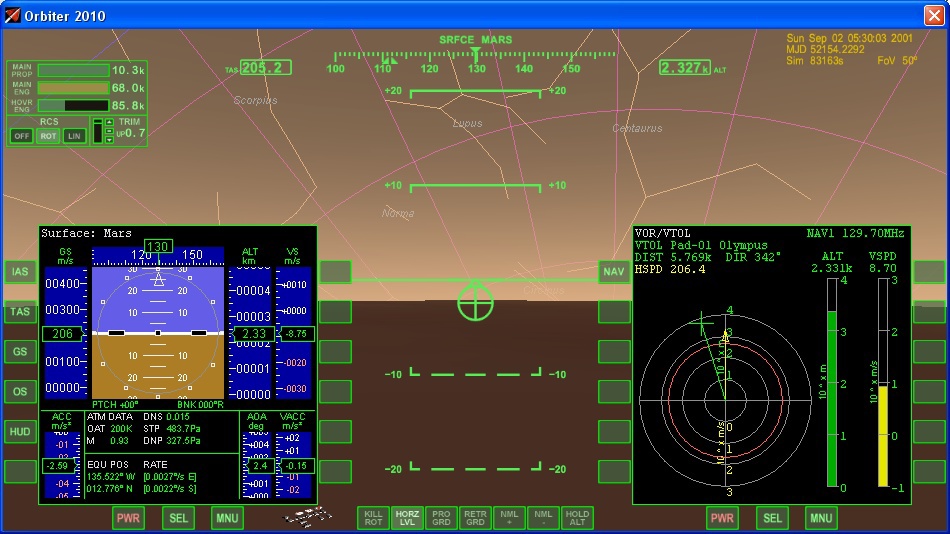
Our task is to finally stop, turn our nose to the base and begin a slow rapprochement. Do not forget to follow the vertical speed!

We produce the chassis, a little remains:

Last meters:
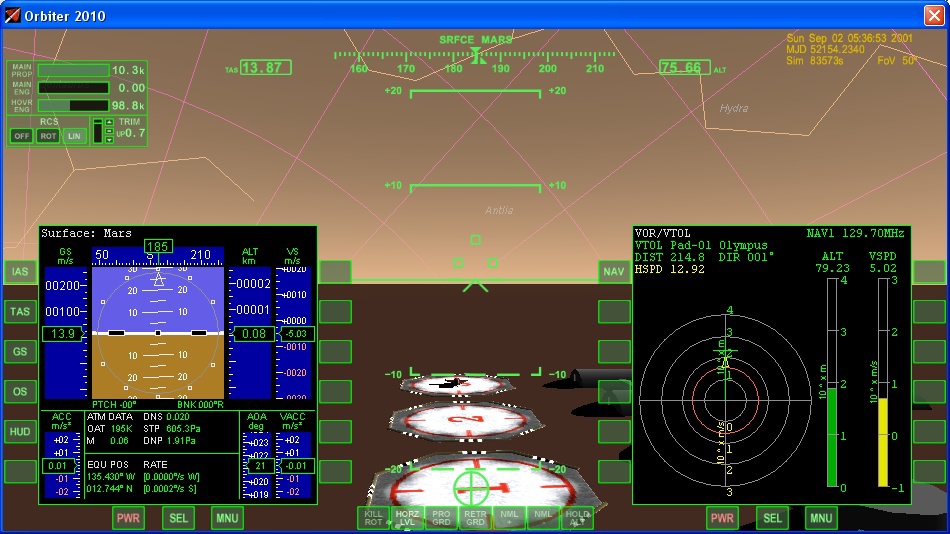
There is a landing!
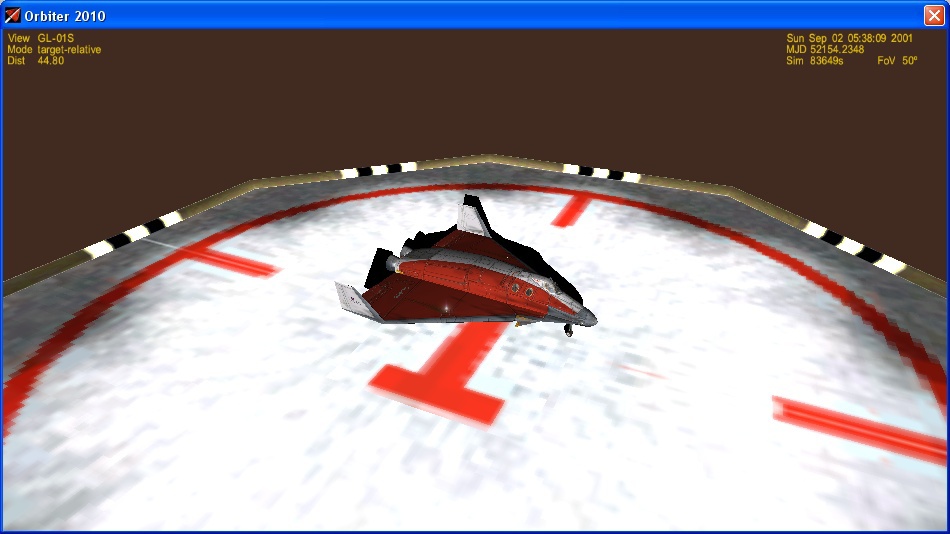
In general, landing on Mars is more complicated than on a body without an atmosphere like the Moon. The atmosphere does not allow you to occupy an arbitrary position, you have to fly your nose forward. And on the other hand, it is not enough for the full work of the wings.
Conclusion
Do not forget to save. Suddenly you want to fly to Phobos, or go back to Earth?
For the curious, there is a manual translated into Russian . You can also read other posts in the Orbiter series .
